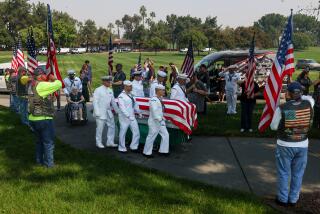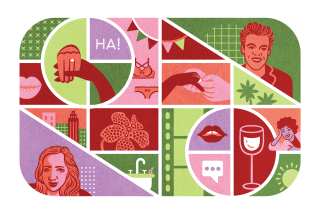For 60 Years, She’s Kept a Niche in Her Heart
- Share via
NEW YORK — Estelle Spero, hopelessly in love, tried her best to talk her sweetheart out of enlisting after the attack on Pearl Harbor.
But he couldn’t be stopped, and on April 24, 1942, Sidney Diamond headed to Fort Dix, N.J., for Army training.
And the letters began.
“Darling, I have no regrets, no longings, no homesickness except the gnawing hunger to be near you -- to speak with you -- to press your hand in mine and stroll,” he wrote. And later, from the South Pacific: “Stay with me and so help me I’ll do my damnedest to get out of this mess in one whole piece.”
The letters stopped in early 1945. But Spero hoped for the best: that he was too busy to write, or that there was a mail problem. In March 1945, she learned the worst: Lt. Sidney Diamond was killed on the island of Luzon two months earlier.
Today, the young woman who kept her heart open while her beau fought in war is 80 and happily married. But she brims with emotion when she talks about Diamond.
All these years, she has kept Diamond’s 525 letters, folded into packets, tied by string, organized by date. And this year, more than six decades later, she honored the memory of their love by publishing a book of their wartime correspondence.
“He wrote almost every day, every two days, long letters, and I kept all of them,” the now Estelle Lynch said in an interview at her home on a quiet block in Queens. “And every time I moved, the letters went with me.”
The two met at a park near Yankee Stadium in the Bronx when she was 14 and he was 16. “As time went on we got closer and closer and we were in love,” said Lynch. “And then along came Pearl Harbor, and he was a very principled person.”
In letter after letter, Diamond describes the details of his everyday life: shining his shoes, a demerit for dirty fingernails, the kindness of a fellow soldier who made his bed for him.
His prose, full of jokes and often punctuated by dashes, expresses optimism and hope sometimes tinged with sadness and loneliness.
As time went on, he wrote of the hardships of war -- of his attempts to write to the wife of a fallen soldier, of tossing and turning while trying to sleep in his tent, of “jungle itch.”
In December 1944, he wrote: “‘Stelle -- I don’t understand it -- I thought I did in the beginning but after what I’ve seen I can’t comprehend why people fight -- why there are wars -- Why bodies, minds, souls are twisted, warped, torn ....”
Lynch last saw Diamond on May 16, 1943, two days after he put a diamond engagement ring on her finger in Central Park while on a 10-day leave.
Back in Texas at Camp Swift, Diamond wrote, “I must have my shoes filled with lead to keep me from going up in the air -- Yep -- I’m happy too.”
Diamond left for the South Pacific on June 27, 1943, and it became more difficult to determine his location. But Lynch knows he spent time in New Caledonia, Bougainville and finally the Philippines.
In his last letter to her, dated Jan. 19, 1945, he wrote, “Somewhere in the Philippines -- In combat again -- a lot to say but -- A. very tired -- B. very very dirty. -- C. Busy, Busy as all hell -- been moving constantly -- Excuse brevity -- I love you -- you make my fox hole warm and soft -- Sweetheart -- Your Sid.”
She found out he had died when his obituary was sent to the boarding house where she was living while a graduate student at Northwestern University. The New York Times obituary said Diamond, with the 82nd Chemical Battalion, was killed by Japanese mortar while acting as forward observer during an assault on Ft. Stotsenburg as U.S. forces tried to retake the Philippines.
Lynch still has the diamond he gave her, now set in a new ring with another from a man she later married and divorced. She is happily remarried and said her husband, while hesitant at first, came to understand how important the book was to her.
“When I started, he was very much against it,” she said. “Why rake up the past?” he’d ask her. But as time went on and he saw that it meant a lot to me, he became very supportive.”
Lynch, who taught speech and English as a second language at Queens College until retiring in 1986, got the idea for the collection after she sent some of Diamond’s letters to Andrew Carroll for his book “War Letters,” and they were accepted.
She typed the letters she selected into her computer, and when she wasn’t able to find a publishing house, she decided to self-publish. She has been selling copies on the Internet: on a website set up by her son, as well as Barnes & Noble and Amazon.
The title, “An Alcove in the Heart,” comes from a letter Diamond wrote on Christmas Day 1944, which she said was one Carroll used. It reads, in part:
” ... I love you darling. -- Whatever happens -- be happy -- that’s my only request -- get everything we would have liked -- fill your life -- (er, -- only keep my little niche open -- so if I ever get home -- I’ll know there’s one place waiting for me -- my corner of the world -- Let it be a small alcove in your heart -- put a comfortable chair there and always keep a warm fire glowing -- because if I come home in any recognizable form I’ll head directly for that chair -- That’s where I belong -- that’s my home -- with you -- ) ....”
Lynch said she hopes readers will take from the book some understanding of their romance, the war -- and Sidney Diamond.
“I want them to think this was a great love story. I want them to think that no one should be separated by war,” she said. “I want them to think that he was a very special guy.”
More to Read
Sign up for our Book Club newsletter
Get the latest news, events and more from the Los Angeles Times Book Club, and help us get L.A. reading and talking.
You may occasionally receive promotional content from the Los Angeles Times.










